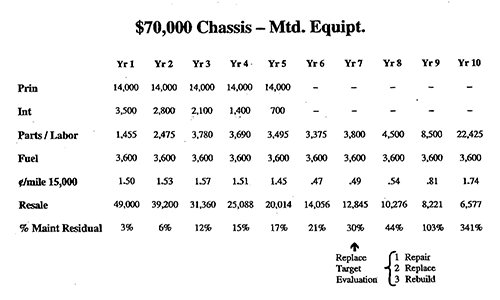Fleet Management Information for Sweeping Professionals |
The 50/50 Rule: A Discussion of Relative Maintenance Costsby John Dolce
This article is adapted from information provided at the National Pavement Exposition West in late 2006. One of America's icons of fleet management provides food for thought when to get rid of current vehicles in your fleet. Are there vehicles in your fleet that are breaking the 50/50 rule? Let's begin by talking about repair costs under warranty. After all, that's when your maintenance costs will be the lowest. Unfortunately, that's also when some people neglect to take the action needed to get reimbursed by the manufacturer. Don't let that happen to you with your newer vehicles. Be sure to keep track of your potential warranty items so you don't have expenses for what should be warranty-covered problems. Remember: In the first year or so after you get a vehicle, your costs should pretty much be warranty-covered aside from the consumables, like tires, fluids, filters and so forth. After that, if you had a large enough fleet you could predict with a high degree of accuracy when to replace your vehicles. Fortunately, even with a small fleet -- or a single vehicle -- there's a phenomenon that will help you decide when to replace your vehicles as long as you track your repair costs well. You can do this by tracking the relative proportion of labor vs. parts in your vehicle repair costs. It's something you definitely should rely on when you're managing your fleet. (Dolce offered a handout that showed repair work for an actual fifty vehicles was $760,000, and that a little over $360,000 was for parts and a little over $390,000 was for labor.) The point is that we know with large fleets that, until major items start breaking, about fifty percent of repair costs are for parts and fifty percent will be labor. If you look at your expenses for maintenance on your vehicles, whether you fix them in-house or you do it with a vendor, for whatever dollars you spend in labor you should be spending about an equal number of dollars for parts. If a particular vehicle is violating the 50/50 rule, on average, there's something wrong. (This is true only if you use your real costs, which in the case of the example were $65/hour. For more on valuing the actual costs of in-house labor, see Dolce's article entitled 'Determining Whether to Work on Vehicles In-House or to Sub Out the Work.' There's also a link to this article at the bottom of the page.) However, bear in mind that if the vehicle is only two to three years old you're going to be labor-intensive, since most parts that break will be relatively minor. Then, as a vehicle gets older the repairs will tend to become more parts-intensive. That's because on older vehicles you're going to start replacing major items, like transmissions, rear ends, chassis rebuilds and doing take-apart engine work. In between, what I call 'head in the oven and feet in the freezer,' the vehicle should adhere to the 50/50 rule. This general rule means that if you see you're spending two dollars in parts to one dollar in labor (or, conversely, two dollars in labor to one dollar in parts on a consistant basis) then it's time -- maybe past time -- to evaluate whether you should continue to repair the vehicle. It's a 'mathematical indicator point' where savvy fleet managers often choose to rebuild, scrap or sell a given vehicle. Your overall costs shouldn't be that parts- or labor-intensive, whether the work is being done in-house or by an outside vendor. Keep in mind that using the information you collect for a current vehicle is a good way to analyze when to sell the next vehicle you purchase of the same type. Another indicator of vehicle aging is calculating a vehicle's repair cost, as a percentage of its total maintenance cost to its residual value. When this figure hits 30% in a given year, chances are it will rise to 50% the next year, 100% the year after and then approach a whopping 350% the following year. 
So, when a vehicle's repair cost hits 30% of the its residual value a professional fleet manager recognizes a serious evaluation -- and accompanying decision -- needs to be made. Typically, this means either removing the vehicle from the fleet and replacing it, or subjecting the vehicle to a major rebuild. Looking at the typical example shown in the graphic above, this decision would be mandated in year seven. The 30% 'mathematical indicator point' is a motivator to be proactive, rather than reactive, which benefits the company whether it's growing, consolidating or staying the same size. It is important that you maintain a vehicle maintenance system that can forecast all this for you. Only by keeping good repair numbers will you have objective information that tells you when it's time to replace a given vehicle. For that reason, your work order should have a place to call out parts and labor. However, I suggest you also put in codes for components, so you can tell what needed replacement. Also note whether the work was scheduled, unscheduled, standard protocol, or warranty work. One reason is that unscheduled work also carries other costs to it, since the machine often must be towed, the route is missed, etc. Best is to use an accounting program that has a maintenance package attached to it. That makes it easy to analyze these types of costs. Or, if you just have two or three vehicles, you can do it by hand as long as you keep track of your overall repair ratios as they occur so that you don't lose track of the big picture. The above information needs to be used as a guideline, not gospel, and tailored to your individual fleet management situation. However, by using this rule of thumb you should be able to minimize your fleet management costs. John E. Dolce has more than 30 years of experience operating fleets of various types and sizes, in both the public and private sectors. Dolce conducts university-level seminars on vehicle maintenance, management, and fleet management in the US and Canada, and has written two texts on the subject. John Dolce can be reached at (973) 226-9061. Dolce offers a handout called 'Daily Vehicle Management Activity.' This is available for download as a pdf file from WorldSweeper.com's forms area. Two other fleet management articles by John Dolce are offered on the WorldSweeper.com website. These are entitled 'Managing Tomorrow's Fleet Assets Today,' and 'Determining Whether to Work on Vehicles In-House or to Sub Out the Work.' |
© 2005 - 2021 World Sweeper
|
Back to Fleet Management InformationSite Map / Table of Contents |